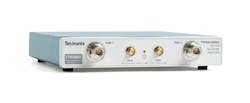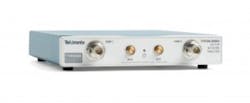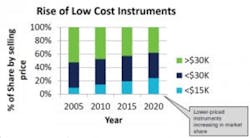Tektronix enters vector network analyzer market with 6-GHz USB model
Tektronix today entered the vector-network-analyzer market by introducing the TTR500 Series USB model. Jon Spurlock, product marketing manager, said the move is to help meet “the desire for wireless everywhere,” with 50 billion devices expected to be connected to the Internet by 2020.
The TTR500 Series full 2-port, 2-path S-parameter VNA can serve such applications asIn a recent phone interview, Spurlock cited April 2016 Markets and Markets figures forecasting a 33% CAGR for the IoT market, reaching 661.74 billion by 2021. The industrial IoT alone will account for $195.47 billion by 2022, according to a February 2017 report from the firm. This growth, Spurlock said, is resulting in a proliferation of wireless standards and making it necessary for engineers to have RF and microwave design experience as they contend with shrinking times to market and an increased number of projects.
Designers are also facing limited budgets that can preclude the use of expensive, shared high-end equipment that RF experts have traditionally used, Spurlock said. In contrast, IoT designers look to avoid RF testing when possible, making use of pre-certified RF modules. As a consequence, Spurlock said, lower priced instruments are increasing in market share.
Those lower priced instruments include USB versions, such as Tektronix’s RSA306, RSA5xx, and RSA6xx real-time spectrum analyzers. The new TTR500 Series complements these instruments, delivering a combination of low price and performance. At $12,000 for a 6-GHz model, the instruments cost 40% less than alternatives capable of 122-dB dynamic range and 6-GHz frequency range, Spurlock said. The 3-GHz version costs $9,000.
The instruments also include advanced features like the new VectorVu-PC analysis software and a built-in bias tee for testing active devices. Accessible on both ports, the bias tee allows for active devices, such as amplifiers, to be DC-biased, making it unnecessary for users to contend with an external bias tee or pay a premium for an instrument with an optional internal bias tee. The TTR500’s built-in bias tee allows for 0 to ±24 V and 0 to 200 mA on both ports.
Spurlock said the instruments can find use in budget-conscious manufacturing and education as well as R&D.
The VectorVu-PC analysis software, Spurlock said, is optimized for touch and mouse control, making it easy to calibrate, make measurements, add markets, and perform trace math. The software can generate and analyze Touchstone (.SnP) files and supports SCPI commands for compatibility with traditional VNAs and to smooth integration into existing test systems. The software has an offline mode for data analysis. It runs on Windows 7 and up.
“With its innovative architecture and disaggregated design, the TTR500 Series achieves the same level of performance as a benchtop VNA, but at 40 percent lower cost and one-seventh the size and weight of units with comparable performance,” said Jim McGillivary, general manager of RF and Component Solutions at Tektronix, in a press release. “This new architecture also greatly reduces the number of components in the instrument which reduces complexity for better reliability compared to traditional benchtop VNAs. The RSA306 disrupted the spectrum analyzer and I’m confident the TTR500 Series will have the same impact for the VNA.”
Rounding out the solution, the TTR500 Series is available with a robust set of accessories including a rugged carrying case, rack mount kits, rugged phase-stable cables, attenuators, adapters and calibration kits.
To learn more, visit www.tek.com/TTR500.
About the Author

Rick Nelson
Contributing Editor
Rick is currently Contributing Technical Editor. He was Executive Editor for EE in 2011-2018. Previously he served on several publications, including EDN and Vision Systems Design, and has received awards for signed editorials from the American Society of Business Publication Editors. He began as a design engineer at General Electric and Litton Industries and earned a BSEE degree from Penn State.


